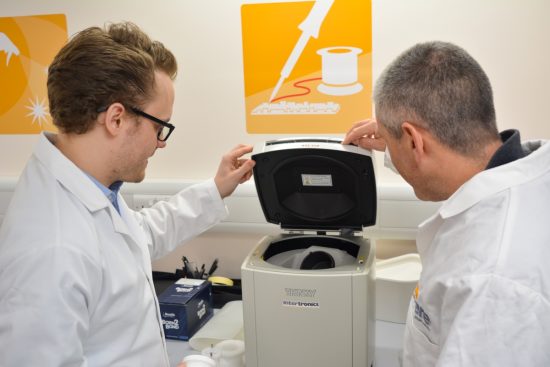 In the scientific community, particularly in universities, THINKY Mixers are becoming more prominent as a way to mix challenging liquids, pastes, and powders in research into nanotechnology, batteries, electronics, pharmaceuticals, and many more applications. A simple Google Patents search for “THINKY” demonstrates the huge number of technology and scientific breakthroughs that relied on the abilities of these mixers to create a fast, homogenous mix. As demand for the technology in lab applications grows, let’s discuss the increased use of THINKY Mixers and shares some interesting examples from laboratories.
In the scientific community, particularly in universities, THINKY Mixers are becoming more prominent as a way to mix challenging liquids, pastes, and powders in research into nanotechnology, batteries, electronics, pharmaceuticals, and many more applications. A simple Google Patents search for “THINKY” demonstrates the huge number of technology and scientific breakthroughs that relied on the abilities of these mixers to create a fast, homogenous mix. As demand for the technology in lab applications grows, let’s discuss the increased use of THINKY Mixers and shares some interesting examples from laboratories.
THINKY Mixers are based on “planetary centrifugal mixing”, a non-contact mixing action that involves rotating containers around their central axis at a 45° angle whilst at the same time revolving them around a central point. The rotations and revolutions are very fast — ~1,000s of RPM — generating mixing forces of about 400 G.
Unlike machines that rely on the insertion of paddles or impellers into the material, no air is introduced; in fact, there is a tendency for it to be removed. In some circumstances, mixing under vacuum is needed to get the required air-free result. In these cases, the planetary mixing is done under a vacuum in mixers with integral vacuum pumps.
There are many reasons this technology is attractive to laboratory teams. THINKY Mixers homogeneously disperse challenging compounds in seconds to minutes, providing consistent results. In addition, a THINKY Mixer enables research teams to document the exact time and speed of mixing, making the process parameters trackable. Because mixing takes place in removeable containers, the cleaning process is straightforward, saving time, avoiding cross contamination, and making it easier for the technology to be repurposed for other applications.
THINKY Mixers for 3D printed bioelectronics research
To improve the way recovery from injury and the progression of neurological/musculoskeletal conditions are monitored, the Department of Automatic Control and Systems Engineering (ACSE) team at the University of Sheffield is developing a diagnostic glove that includes several flexible bioelectronic sensors. The sensors are formed from elastomers mixed with various conductive nano or micro particle compounds, like graphite, platinum, and silver, which are 3D printed onto the glove’s material.
The process involved mixing nanoparticles into very viscous filled polydimethylsiloxane (PDMS) mixture to produce a graphite composite. After trialling a THINKY Mixer, the most prominent benefits to the ASCE have been removing the need for solvents as a mixing aid, removing a step from the process, improving health and safety, and increasing repeatability.
“The THINKY Mixer is a huge improvement on our previous process and means we can achieve consistent outcomes more quickly,” said Tom Paterson, Postdoctoral Research Associate at The University of Sheffield. “The mix quality is extremely good, the mixer doesn’t introduce air into the mix, and we’re making a substantial time saving.”
Applications from the field
A search of Nature.com brings up more than 150 results for “THINKY”. Recent examples of researchers applying the technology include the development of a soft pressure sensor applicable to wearable robots, and the transformation of plant proteins into high performing lubricating microgels.
One interesting example comes from the University of Bern, Switzerland, where a team of researchers was developing a microfluidic platform for the formation and maintenance of blood micro-vessels. One of the key issues during the microfluidic production was the complete filling of all the microstructures with uncured PDMS. The team wanted a way to reliably prevent air bubbles becoming trapped in the PDMS. A THINKY Mixer was used successfully during the process, enabling the team to simultaneously mix and degas the material.
Beyond researchers, students can also benefit from the technology. In 2022, Ed Harrison, a student at the University of Birmingham undertook an eight-week placement with battery researchers as part of the Faraday Undergraduate Summer Experience and created a poster, which is published on faraday.ac.uk. It covers how he used a THINKY Mixer to make a homogenous mix of active material (NMC/LFP) and carbon black during the preparation of cathode material coatings.
With their ability to quickly transform multiple parts of liquids, pastes and powders into homogenous, ready to use materials, planetary mixers form an integral part of a repeatable mixing process for many laboratories.
To find out more about using THINKY Mixers, watch our 90 second video, or try one out for yourself in our Technology Centre.
Categories: case study, medical, mixing, nanotechnology, pharmaceutical
